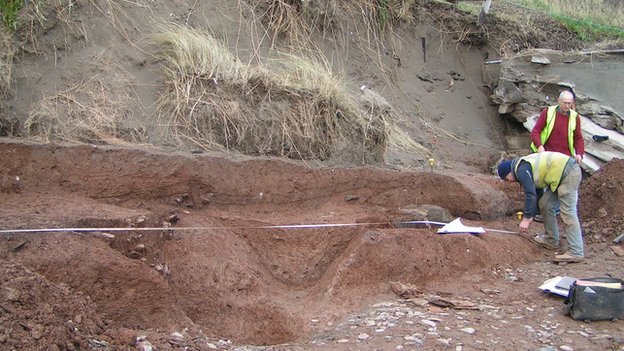Ancient 5,000-Year-Old Forest Unearthed by UK Storms
The skeletal trees are said to have given rise to the local legend of a lost kingdom. A sign for extreme change is when storms destroy ancient landmarks, unearth 1 million old foot prints or reveal pottery from the Iron Age and Romano-British time.
Now, they discovered ancient forest stumps.
The BBC explains: Geologists believe extensive forests extended across Mount’s Bay in Penzance between 4,000 and 6,000 years ago. The shifting sands have also revealed wrecks, an iron age settlement in Devon and wartime explosives in Devon, Somerset and Dorset. Remains of ancient forests have also been seen on Portreath beach, Daymer Bay in Cornwall and Bigbury Bay in Devon.
Frank Howie, Cornwall Wildlife Trustee and chair of the county’s Geoconservation Group, said submerged forests were evidence of changes in Mount’s Bay as the sea level had risen. He said: “The storms have revealed trunks of pine and oak as well as the remains of hazel thickets with well-preserved cob nuts and acorns washed out by streams running across the beach.
“At Chyandor to the east of Penzance rooted stumps are exposed in situ in peaty soils and massive trunks have been washed out onto the rocky foreshore. “These forests were growing four or five thousand years ago when the climate was slightly warmer than today.”


The Guardian notes: The forest of Borth once stretched for miles on boggy land between Borth and Ynyslas, before climate change and rising sea levels buried it under layers of peat, sand and saltwater.
Scientists have identified pine, alder, oak and birch among the stumps which are occasionally exposed in very stormy winters, such as in 2010, when a stretch of tree remains was revealed conveniently opposite the visitor centre.
The skeletal trees are said to have given rise to the local legend of a lost kingdom, Cantre’r Gwaelod, drowned beneath the waves. The trees stopped growing between 4,500 and 6,000 years ago, as the water level rose and a thick blanket of peat formed.
This year a great swath of the lost forest has been revealed. Last month archaeologists also found a timber walkway nearby, exposed by the storms. It was discovered by Ross Cook and Deanna Groom, from the Royal Commission on the Ancient and Historical Monuments of Wales, who went beach walking in the wake of the storms to check for any new finds. It was made from short lengths of coppiced branches, held in place with upright posts.
Related
UK weather: British coasts suffer years of erosion in just weeks of storms, says National Trust – Alan Kearsley-Evans, the Trust’s countryside manager for Gower, said: “We’d be planning for this happening but in 10 years’ time, not now.” The Birling Gap in East Sussex which has seen about seven years of erosion in just two months.
About the Author: CLIMATE STATE
POPULAR
COMMENTS
- Robert Schreib on Electricity generation prices may increase by as much as 50% if only based on coal and gas
- Robert Schreib on China made a historic commitment to reduce its emissions of greenhouse gases
- Lee Nikki on COP30: Climate Summit 2025 – Intro Climate Action Event
- Hollie Bailey on Leaders doubled down on fossil fuels after promising to reduce climate pollution
- Malcolm R Forster on Mythbusters tests global warming theory – does CO2 warm air?
[…] round-up from February 2014 Ancient 5,000-Year-Old Forest Unearthed by UK Storms http://climatestate.com/2014/02/21/ancient-5000-year-old-forest-unearthed-by-uk-storms/ Flooding And Erosion Damage Across The UK – Aerial Footage […]